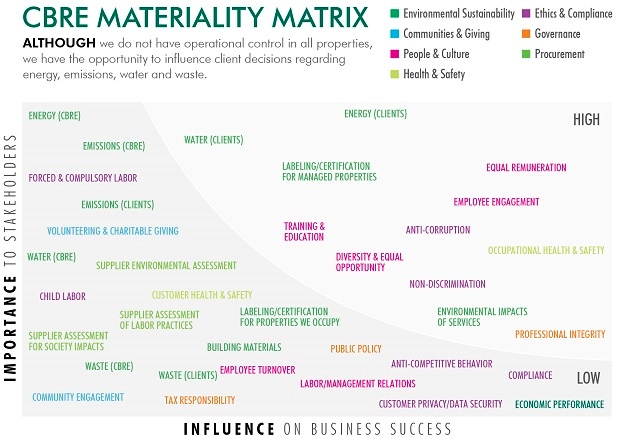The following is excerpted from The State of Corporate Citizenship 2017. To learn more about how you can prioritize the corporate citizenship issues that are most important to your stakeholders and business context, consider joining online from October 2-November 22, 2017 for our Materiality: Determining Priorities for Corporate Citizenship Strategy and Reporting course.
While the 2017 State of Corporate Citizenship shows a declining interest in formal stakeholder engagement among executive respondents, engaging with both internal and external audiences can be an important component of any corporate citizenship program. Through stakeholder engagement, companies can fully understand their social, environmental, and economic impacts, and prioritize the issues that are most important to both stakeholders and their business context.
Many companies, like CBRE—the world’s largest commercial real estate services firm—use the insights they gather from stakeholders to inform a materiality assessment, creating a roadmap for more strategic time and resource allocation, and more comprehensive reporting.
“Corporate citizenship strategy development and sustainability reporting are complex tasks that require detailed information. Gathering all of that data can be complicated and time consuming, but you have to start somewhere,” said Jennifer Leitsch, director of corporate responsibility at CBRE. “A materiality assessment will ideally produce a matrix that will tell you what’s important to your own firm, as well as to your stakeholders.”
In 2015, the CBRE corporate responsibility team analyzed reporting frameworks and indices such as GRI and the Dow Jones Sustainability Index (DJSI) to identify 55 issues that would be considered material to their business. They then narrowed the list to 35 according to rankings by both internal and external stakeholders. The company’s internal stakeholders included all members of CBRE’s Corporate Responsibility Steering Committee, which is comprised of leaders from throughout the organization’s business lines and geographies. This team was asked to rank issues by how significant they were to CBRE. External stakeholders—including clients, suppliers, and NGOs—were asked to rank items on the basis of how the issues might affect their judgment about CBRE.

This process has informed CBRE’s corporate citizenship strategy, as well as its most recent corporate responsibility report. Now, the company has already begun another materiality assessment, recognizing that the most effective stakeholder engagement is achieved through regular dialogue.
“We know that stakeholder engagement is a continuous process,” said Leitsch. “In addition to reaching out for the materiality assessment, we engage with stakeholders throughout the year in a variety of ways such as customer satisfaction surveys, research studies, interviews, and appearances at conferences and events.”
By determining the alignment between the constraints and opportunities of its operating context and the needs and expectations of those it impacts, CBRE is achieving value for both business and society, an outcome it calls Shared Advantage.
“At CBRE, we understand that our influence extends beyond the boundaries of our work,” said David L. Pogue, global director of corporate responsibility at CBRE. “We recognize that the impact of small, positive acts multiplied across our broad global enterprise can improve the communities we serve, while at the same time grow our bottom line. When those positive acts flow naturally from the business process, our organization evolves beyond its public persona to deliver a mutual benefit to all of our stakeholders.”